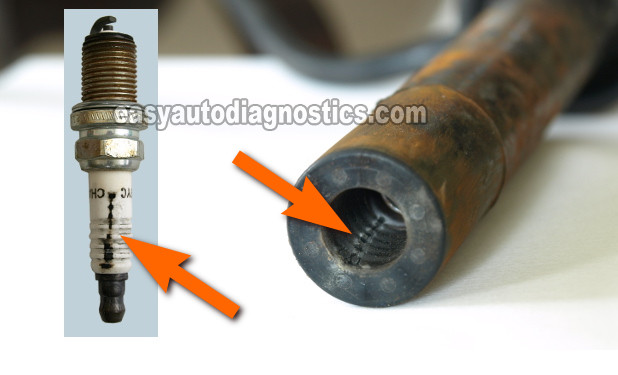Carbon Track Inside The Spark Plug Wire Boot

You'll notice that the arrow, in the photo, points to the carbon track on the spark plug boot. Keeping in mind that electricity prefers the path of least resistance, the spark will find a super easy path to Ground thru' the carbon track. Having to jump the air gap between the center electrode and the side electrode of the spark plug would be a thousand times harder.
This carbon track will always run in a straight line starting from the metal terminal inside the boot to the end of the boot. The spark plug will usually have the corresponding carbon track on its ceramic insulator (see the photo on the previous page). This carbon track may be fully formed and highly visible or barely visible to the naked eye.
If evidence of a carbon track is found, BOTH the spark plug and its spark plug wire MUST be replaced because a carbon track can not be removed. If you clean it/scrape it off, it will return! In the case of the Dodge Neon, a new set of ignition cables and spark plugs where installed.
Even tho' this case study involved a vehicle with a coil pack. The flow of tests apply to any vehicle. Whether the vehicle has a distributor ignition system or a Coil-On-Plug system or an ignition coil pack. They are all susceptible to carbon tracking.
When performing a tune up, it's critical that the you visually inspect for carbon tracking on the inside of the spark plug wire boot.
A carbon track is only one of many issues that could cause an ignition misfire. If you suspect that carbon tracking is causing the misfire, following a path like what was explained in this article will help you diagnose the problem quicker and do it without expensive testing equipment.
You can tailor the following testing guideline to fit your specific situation.
- Check for trouble codes first.
- Check for spark with a HEI spark tester.
- Start at the source: which is connecting the spark tester at the spark plug wire and back track from there.
- The purpose of this test is to verify that the ignition coil and the spark plug wire are working.
- If no spark is present, then it's a hard fault with the ignition coil or the spark plug wire and NOT a carbon track issue.
- If spark is present, then I visually eye-ball the inside of the spark plug wire boot for carbon tracking.
- Remove the spark plug(s) indicated by the misfire code and eye-ball it for carbon tracking and or cracks.
- You'll want to check that the spark plug and its boot are not soaked in engine oil.
- Oil soaked spark plugs will misfire.
- Remove all of the spark plugs and visually inspect their boots and ceramic insulators.
Well, we've come to the end of the story, thanks for letting me share it with you! If this article was helpful, please feel free to roam around the rest of the site!
For further reading, I recommend the following articles (within this site):
- NO START diagnostic tips.
- Ignition system basics.
- Testing an ignition coil pack.
- Testing a Coil-On-Plug ignition system.
- Case study of how to diagnose a 'does not crank' condition.
- The HEI spark tester.

If this info saved the day, buy me a beer!

